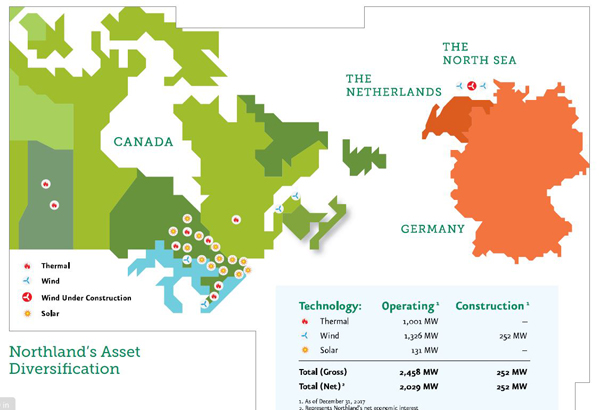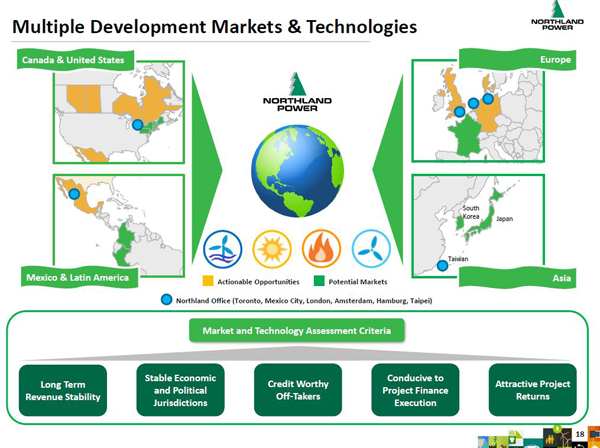To anyone who has watched the trajectory of Northland Power, it has been more than a typical success story. Steady growth throughout the company’s history has given way to an impressive period of international expansion in the last five years, leading to the emergence of Northland as a global leader in the development of new power generation capacity. Focused on what it calls “intelligent energy,” the company has adroitly identified and moved into a series of economic opportunities as energy markets successively opened up new subsectors in independent power, co-generation, renewable energy, and large scale offshore wind power.
Northland currently has 27 operating facilities comprising over 2,400 MW of capacity and a development pipeline of opportunities representing approximately 6,000 MW. The company’s enterprise value is approximately $12 billion.

Northland has developed a positive reputation in the power sector. The company notes that it has “a strong track record of on time, on budget project delivery.” As a full lifecycle developer, builder and owner of their projects the company believes it is organized “to ensure facilities are high quality and efficient from conception, through operation, to retirement.” Safety is also a priority, as demonstrated by no lost time incidents across the organization in 2017.

The company has recently opened new offices in Mexico City, Hamburg, Taipei, London and Amsterdam, no doubt assessing the potential for significant new growth in power generation opportunities in keeping with its emphasis on clean and green development.
Throughout its history Northland Power has broken new ground, often chalking up achievements that rank as historic “firsts.” Its Kirkland Lake project was the first IPP in Canada to attract institutional financing. Its Nordsee One project was the first offshore wind project to use only commercial financing. At the time of financial close, its Gemini wind project was the largest renewable project financing to date. (See the chart of Northland firsts below for more examples.)
 Significant highlights in Northland’s history include the following:
Significant highlights in Northland’s history include the following:
• 1987: Northland Power is established – it was one of Canada’s first independent power producers.
• 1990: Northland’s first project, the 42 MW Cochrane, Ontario thermal facility, begins operations (closed in 2015). It was the first Canadian independent power plant to use unprocessed wood chips as fuel.
• 1991: Kirkland Lake begins operations – 132 MW baseload thermal plant located in Ontario and contracted to 2030. It was the first independent power project in Canada to attract institutional financing.
• 2006: Northland acquires its first international projects – two operating wind farms in Germany with a total capacity of 22 megawatts (sold in 2017).
• 2009: Northland completes a second on-shore wind farm in Québec: 133 MW Jardin D’Eole – contracted to 2029. Northland Power Income Fund completes merger with NPI (private developer), a key milestone in the organization’s growth trajectory.
• 2010: Thorold Cogeneration Station, a 265 MW thermal facility, begins operations in Ontario – contracted to 2030.
• 2013: Northland successfully completed the 260 MW North Battleford Facility in Saskatchewan, and began operations on the first of thirteen ground-mounted solar facilities in Ontario, each with 20-year power purchase agreements. The same year it announced majority ownership of the 600 MW Gemini project, becoming the first Canadian energy producer to enter this thriving sector.
• 2014: Northland acquires 85% ownership of a second offshore wind farm, 332 MW Nordsee One, located in the German North Sea (near Gemini). McLean’s Mountain, a 60 MW wind farm located on Manitoulin Island in Ontario, is completed. The project is a 50/50 partnership between Northland and the United Chiefs and Councils of Mnidoo Mnising.
• 2016: Northland completes construction of the 100 MW Grand Bend wind farm located in Ontario; the project is a 50/50 partnership with the Aamjiwnaang First Nation and Bkejwanong Territory.
• 2017: Gemini and Nordsee One begin commercial operations – both projects are completed on or ahead of schedule and under budget. Northland acquires 100% ownership of a third project, 252 MW Deutsche Bucht, currently in construction.
 Looking to 2018 and beyond, Northland literature notes that, “The energy sector, like the world around it, is changing rapidly. Northland is evolving right along with it, pursuing development prospects in gas, wind, solar and hydro in a number of jurisdictions, including, but not limited to, North America, Europe, Mexico and Taiwan. The future is bright.”
Looking to 2018 and beyond, Northland literature notes that, “The energy sector, like the world around it, is changing rapidly. Northland is evolving right along with it, pursuing development prospects in gas, wind, solar and hydro in a number of jurisdictions, including, but not limited to, North America, Europe, Mexico and Taiwan. The future is bright.”
In August, Northland’s CEO John Brace will retire, after 30 years with the company, although he will continue to guide Northland through his role on Northland’s Board of Directors. Mike Crawley, Northland’s Executive Vice President, Development, has been appointed to the role of CEO effective August 4th. In a press release announcing the transition Northland’s founder and Chair, James Temerty, C.M. said, “We would like to thank John for his invaluable leadership and immense contributions to the success of Northland. We have achieved some truly great things together. We also welcome Mike into his new role as Chief Executive Officer. Mike has continuously demonstrated Northland’s values in action and proven that we made a great hiring decision in 2015. We look forward to sustaining our excellent track record and to delivering continued growth.”
Although firmly based in Canada, Northland Power is now clearly focused on both national and international opportunities. It has a significant presence in Europe and is planning a 3rd offshore wind project in the North Sea. Opportunities in Asia are significant. It has established a meaningful presence in Taiwan where Northland and its partners are currently in advanced site development. Its Hai Long 2 project was allocated 300 MW grid allocation under that country’s FIT program.
Northland says its vision is “to be a top clean and green power producer, inspiring our people to achieve a sustainable and prosperous future for all stakeholders.”
To anyone who has the impression that Canadian industry is timid and unlikely to prevail against large global competitors in international markets, a closer look may be in order. Northland Power has demonstrated that Canadians, even without the benefit of a large domestic market, can build global ventures to rival anything the international market has to offer. The Canadian brand, Canada, and the world, are better for it.
